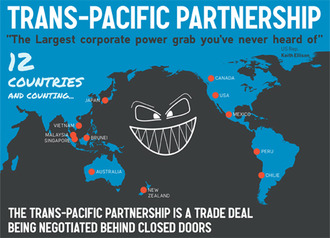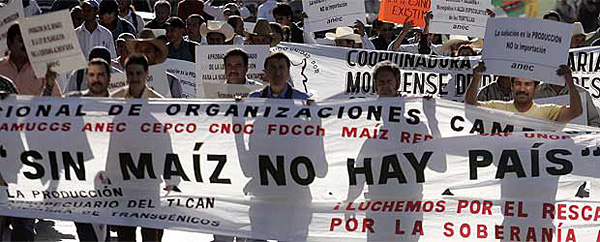by Barry Sheppard
June 5, 2015
The Trans-Pacific Partnership (TPP) currently being negotiated between the U.S. and 11 other countries is a treaty to cover regulations and investments between the countries. While it is being negotiated in secret from the peoples of the United States and the other countries, the negotiations are not being kept secret from the capitalists involved. For the U.S. side alone, some 600 corporate representatives are neck deep in the negotiations.
This gives the game away. The TPP will further the interests of the rich at the expense of workers and peasants. It will codify new regulations to facilitate more neoliberal changes to the economies of these countries. At the same time, it will further the interests of the imperialist countries involved–which include the U.S., Australia, Canada, Japan, and New Zealand–at the expense of the oppressed nations of Brunei, Chile, Malaysia, Mexico, Peru, Singapore, and Vietnam. Capitalists in these latter countries will benefit as junior partners with the imperialists at the expense of their workers and peasants.

In all the 12 countries, there will be new regulations which will weaken laws defending workers (including agricultural workers), small farmers and peasants, and the environment, and empower capitalist firms to even overturn laws they don’t like in the other countries. One objective will be to form a bloc of these countries against China, part of Obama’s “pivot to Asia.”
The TPP has been referred to as “NAFTA (North American Free Trade Agreement) on steroids.” Since NAFTA is now over 20 years old, we can get a glimpse of what is in store with TPP by looking back on NAFTA’s results.
NAFTA was an agreement between the U.S., Canada, and Mexico. When he signed the agreement at the end of 1993, President Clinton promised it would “promote more growth, more equality, better preservation of the environment, and greater possibility of world peace….It will create 200,000 jobs in this country by 1995.”
What is the result 20 years on? Within all three countries wealth inequality has mushroomed, not increased. In no year did the U.S. add 200,000 jobs as a result of NAFTA. In fact, hundreds of thousands of jobs were lost as U.S. corporations used NAFTA’s investment incentives to relocate to Mexico to take advantage of low wages. No environmental laws were strengthened by NAFTA. Big Pharma and chemical industries got their patents extended geographically, and won rights not to be regulated and inspected. Big Oil and Gas got absolute rights to natural resources to pump ever more greenhouse gasses into the atmosphere.
Mexican President at the time, Carlos Salinas, echoed Clinton in a speech given in the U.S., saying “NAFTA is a job-creating agreement,” for Mexico. “It is an environmental improvement agreement.” Most important, he boasted, “It is a wage-increasing agreement.” In this article I want to concentrate of Mexico, where NAFTA has wreaked the most harm.
NAFTA promoters argued that the pact was going to bring new U.S. technology and capital to compliment Mexico’s surplus labor. This in turn would lead Mexico to industrialize and increase productivity, which would cause wages in Mexico to increase. The higher wages would expand economic opportunities, slowing migration to the U.S. The results are in. NAFTA failed to spur meaningful or inclusive economic growth, pull Mexicans out of unemployment and underemployment, or reduce poverty. It has done the opposite.
An immediate result of NAFTA was to gut the land reform embedded in the Mexican Constitution, a vestige of the Mexican Revolution of the early 20th century, guaranteeing small plots to millions of rural Mexicans. It also opened Mexico to the importation of cheaper U.S. corn (maize), a staple of the Mexican diet. As corn prices plummeted, indebted farmers lost their land, which could now be acquired under NAFTA by rich Mexicans and U.S. agribusiness who consolidated prime acres into large plantations. Between 1995 and 2005, 1.1 million peasants lost their land, and another 1.4 million others dependent of the farm sector were driven out of work. They swelled the ranks of the poor being driven into the cities and/or to desperately seek emigration to the U.S. as undocumented workers with scarce legal rights.
The urban poor have difficulty finding jobs. Many are in the “informal” sector, selling candy and trinkets of the streets. Their number has increased since 1994, to half of the workforce. Wages dropped so precipitously that today the income of a farm laborer is one-third of what it was before NAFTA. Although the price of corn plummeted, the price of corn tortillas, a Mexican staple, skyrocketed in the pacts’ first ten years. NAFTA included service sector and investment rules that facilitated consolidation of grain trading, milling, baking, and retailing so that in short order the relatively few remaining large firms were able to raise consumer prices. The result has been an increase in the number of people going hungry.
 Mexican farmworkers protest NAFTA: “without corn, there is no peace.”
Mexican farmworkers protest NAFTA: “without corn, there is no peace.”
The decline of Mexican agriculture has meant an increasing amount of food is imported from the U.S., including processed food, with the irony that obesity is increasing amid hunger. At the higher prices, it is even profitable for U.S. firms to make tortillas and export them to Mexico.
Today over half of the population, and 60 percent of the rural population, is below the poverty line. One in four are classified as extremely poor, unable to afford adequate food, and 20 percent of children are malnourished. From 2006 to 2010, more than 12 million people joined the ranks of the impoverished. Mexico showed the slowest reduction in poverty in all of Latin America since NAFTA.
A minimum wage worker can buy 38 percent fewer consumer goods today than before NAFTA. Clinton and Salinas promised that NAFTA would decrease the wage differential between Mexico and the United States enough to slow emigration, but this differential has barely budged. Mexican manufacturing workers made an average of $4.53 in 2011, while comparable U.S. workers made $26.87. In Brazil, manufacturing wages were double those in Mexico, while they were triple in Argentina. The flood of desperate people into the U.S. has accelerated, not decreased.
It is true that the better off have made gains. While tens of thousands of small businesses have gone under, big U.S. box firms like Walmart and Costco have moved in, selling good imported from Asia to the “new middle class.” There are also pockets of increased exports to the U.S. A recent strike in Baja California (the long Mexican peninsula below the U.S. state of California) pitted big agribusiness against very low paid indigenous workers. These big firms, owned by both U.S. and Mexican tycoons, export an abundance of fruits, berries, tomatoes, and other vegetables north each year, while Mexico cannot feed its hungry. The government, closely connected to the growers, used state violence against the workers.
All this has exacerbated social instability in the country, also furthered by the U.S. “war on drugs.” One of Mexico’s big imports from the U.S. is weapons. With Mexico’s record on “growth, equality, wages, and peace” under NAFTA, small wonder that TPP is viewed with trepidation.
Barry Sheppard is a member of Solidarity in California. This article is adapted from a column Barry writes for an Australian left-wing newspaper.
